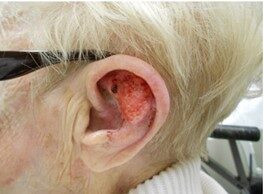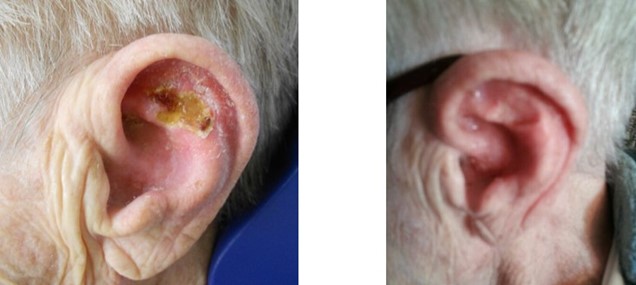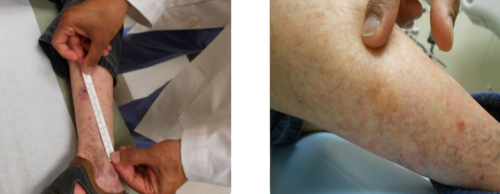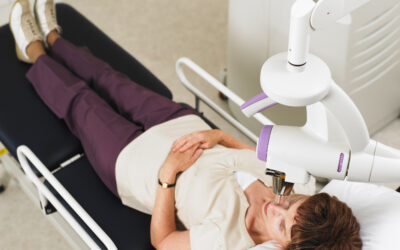For many patients with basal cell carcinomas or squamous cell carcinoma, radiation therapy can yield better functional or cosmetic outcomes than surgical intervention and radiation therapy may be the preferred option. For other patients with medical comorbidities or patients on blood thinners which can complicate recovery from surgery, radiation therapy can be a non-invasive patient-centric treatment option.
The case studies below provide evidence of the benefits of radiation therapy.
Case 1: SCC on ear
A 90-year-old female patient presented with a three-centimeter squamous cell carcinoma (SCC) anti-helical fold and anti-helix (Figure 1). The patient’s electronic brachytherapy treatment schedule with Xstrahl Radiant consisted of 45 Gy delivered over 15 fractions (every other day) using a 35 mm surface applicator, prescribed to 4 mm depth.
Figure 2 shows the last day of treatment (left) and the six-month follow up (right), demonstrating an excellent cosmetic outcome.

Figure 1. SCC (left) and treatment setup.

Figure 2.
Case 2: BCC on nose
This patient presented with a basal cell carcinoma (BCC) of the nasal tip, as seen in Figure 3 (left). He received 15 fractions of electronic brachytherapy using Xstrahl Radiant with 45 Gy in 15 fractions, 2 mm depth. At his six-month follow-up visit (Figure 3, middle and right), there is virtually no evidence of the lesion with an excellent cosmetic outcome.
Figure 3.

Case 3: BCC on eyelid
The patient presented with a nodular basal cell carcinoma (BCC) of the right eyelid (Figure 4, left), for which he received a 45 Gy electronic brachytherapy with Xstrahl Radiant treatment over 15 fractions, 3 mm depth with a lead eye shield used to protect his vision. At the one-year follow-up (right), the patient showed an excellent cosmetic outcome.
Figure 4.

Case 4: RLE lesion
Lesions on the skin of the lower extremities of older patients require extra caution, as their skin is thinner than that of younger patients or they may have a comorbidity such as diabetes. Factors like these can result in poorer healing. The 75-year-old female patient in this case presented with a right lower extremity lesion (Figure 5, left), complicated by diabetes and hypertension.
She was treated with 15 fractions of electronic brachytherapy with Xstrahl Radiant and had an excellent outcome (Figure 5, right).

Figure 5.






